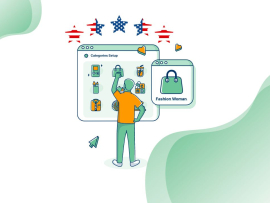eCommerce has become a potent force that may change how companies run and connect with their target markets in a time when technology is still reshaping industries. Since the digital marketplace presents unmatched chances for development and advancement, it is critical for companies to comprehend the essential e-commerce information that might propel their achievement. We’ll look at these important facts in this article and show you how to use them to grow your company.
What is eCommerce?
The purchasing and selling of products and services over the Internet is known as e-commerce, or electronic commerce. It includes mobile shopping and encrypted online payments, among many other data, systems, and tools for online buyers and sellers.
The majority of companies with an online presence manage logistics and fulfilment, carry out e-commerce marketing and sales, and manage their online stores and/or platforms.
Global retail e-commerce sales are expected to reach $5 trillion for the first time in 2022, making up more than 5% of total retail sales, predicts eMarketer. Furthermore, despite slowing growth, overall spending will surpass $7 trillion by 2025.
Let’s examine e-commerce’s development, history, and effects on the business sector in order to gain a complete understanding of it. We’ll also talk about certain e-commerce benefits and drawbacks, as well as future projections. Check out our twice-weekly audio series, the Make it Big Podcast, where global thought leaders talk about everything ecommerce, from growth strategies and success stories to industry news and trends, for more in-depth insights on the move.
Global Reach and 24/7 Availability
Geographical limitations are irrelevant with e-commerce, giving your company access to a worldwide clientele. Online stores that are open around-the-clock allow you to serve clients from various time zones, which boosts sales and broadens your brand’s visibility.

Customer Convenience is King
A key component of e-commerce is convenience. The capacity to purchase from the comfort of one’s home and have goods delivered right to one’s door has caused a dramatic change in consumer behavior. Make sure your website is easy to use, mobile-friendly, and has a quick and easy checkout procedure to increase consumer satisfaction.

Data-Driven Insights
A plethora of information about consumer behaviour, interests, and purchase patterns is produced by e-commerce platforms. By using analytics tools, you may obtain insightful knowledge about your target market and efficiently customise your product offers, marketing campaigns, and user interface to suit their needs.

Personalization and Customer Engagement
Personalised recommendations based on client preferences and history are possible with e-commerce. Make use of this feature to give customers a more tailored purchasing experience, building stronger bonds with them and motivating them to come back.

Building Trust through Reviews and Ratings
Trust is greatly aided by customer ratings and reviews. While negative feedback offers room for improvement, positive feedback has the power to sway prospective customers. Actively solicit reviews from clients and address their issues as soon as possible.

Diverse Marketing Avenues
A multiplicity of marketing channels become available with e-commerce, including pay-per-click advertising, email marketing, influencer collaborations, and social media. There are several ways to connect with and engage your target audience through each channel.

Scalability and Cost Efficiency
E-commerce companies can grow more readily than traditional brick-and-mortar establishments since they are not burdened by the expense of physical infrastructure. You can grow your clientele, operations, and product line with less financial risk because of its scalability.

Competitive Pricing and Comparison Shopping
Online pricing transparency makes it easy for shoppers to compare items and prices. In a crowded market, stand out by offering value-added deals and competitive pricing to draw in customers.

Secure Payment Gateways
Having safe payment methods is crucial to earning clients’ trust. Put strong security measures in place to safeguard private client data and enable secure transactions.

Continuous Innovation
The world of e-commerce is dynamic and ever-changing. Remain abreast of industry developments, integrate novel technologies, and foster creativity to maintain a competitive edge and accommodate evolving consumer inclinations.
To sum up, e-commerce has completely changed how companies interact with their clients and carry out sales. You can take advantage of e-commerce’s enormous potential to expand your company, improve client interaction, and establish a solid presence in the online industry by comprehending and utilising these essential e-commerce facts. Accept the digital revolution and allow e-commerce to revolutionise your company’s operations.

Conclusion
In the grand tapestry of commerce, the narrative has been rewritten by the indomitable force of eCommerce. As we conclude our exploration into “How eCommerce Has Changed the Game,” it becomes abundantly clear that the transformation is not just a momentary shift but an enduring evolution that continues to shape the business landscape.
From the convenience of online shopping to the democratisation of entrepreneurship, eCommerce has torn down barriers, rewriting the rules and creating a level playing field for businesses of all sizes. The seismic shift towards digital transactions has not only changed the way consumers shop but has fundamentally altered the essence of business itself.
The game-changing impact of eCommerce is not solely measured in sales figures or revenue streams; it’s witnessed in the democratisation of markets, the empowerment of small businesses, and the global connectivity that transcends borders. eCommerce has become the conduit for innovation, pushing the boundaries of what is possible in the realm of commerce.
As we reflect on this journey through the transformative landscape of eCommerce, we recognize that the game is not just changed; it’s continually evolving. The future holds promises of augmented reality shopping experiences, artificial intelligence-driven personalization, and even more seamless integration of online and offline retail. The eCommerce story is dynamic, and the game is far from over.
In this era where digital commerce is both the present and the future, businesses that embrace change, adapt to emerging technologies, and prioritise the evolving needs of their consumers will thrive. eCommerce is not merely a chapter in the book of commerce—it’s the narrative that continues to be written, shaping the future of how we buy, sell, and connect in the ever-expanding digital marketplace.
How to Use Woo Commerce FAQ
– Businesses often encounter challenges such as adapting to new technology, managing logistics and fulfillment, maintaining cyber security, and competing with larger online retailers.
– eCommerce has transformed the consumer shopping experience by offering convenience, a wider selection of products, personalized recommendations, easy price comparison, and the ability to shop anytime and anywhere.
– eCommerce allows businesses to reach customers beyond their local markets, facilitating cross-border trade and expanding market reach. It enables consumers to access products and services from around the world, contributing to the globalization of markets.
– eCommerce has provided opportunities for small businesses to compete on a global scale, reach a broader audience, and reduce overhead costs associated with traditional brick-and-mortar stores. However, it has also intensified competition and required small businesses to invest in online marketing and technology.
– eCommerce has disrupted traditional retail models by shifting the focus from physical stores to online platforms. It has led to the rise of multichannel retailing, where businesses integrate their online and offline channels to provide a seamless shopping experience. Additionally, eCommerce has challenged the need for large physical retail spaces and transformed consumer behavior, with more people opting for online shopping.
More Blogs You May Like
A Step-by-Step Guide to Installing the Shopify Trade Theme
Unlock the full potential of your online store with our step-by-step guide to installing the Shopify Trade Theme. From seamless setup to customizations, this guide walks you through every detail, ensuring your store stands out. Elevate your e-commerce game effortlessly and start turning visitors into loyal customers today.
How Much Does it Cost to Develop a Shopify Store in the USA? (2024 Breakdown)
Navigating the costs of launching a Shopify store in the USA? Here’s the 2024 breakdown you need. From domain fees to app subscriptions, we delve into every expense involved. Stay informed, plan wisely, and embark on your e-commerce journey with confidence, knowing the real costs ahead.
A Comprehensive Comparison Guide to Choose the Perfect eCommerce Platform for Your Business
Embark on your e-commerce journey with confidence using our comprehensive comparison guide. We analyze the top platforms, from Shopify to WooCommerce, weighing features, pricing, and scalability. Whether you’re a startup or established enterprise, find the perfect match for your business needs for online success.
10 Best WooCommerce Themes All The Time
Discover the timeless allure of the 10 best WooCommerce themes curated just for you. From sleek minimalism to vibrant designs, each theme offers unique aesthetics and robust functionality. Elevate your online store’s appeal and stand out in the crowded e-commerce landscape with these perennial favorites.
What Are The Things to Consider When Building an eCommerce Website using WordPress
Crafting an e-commerce website on WordPress? Prioritize responsive design, reliable hosting, secure payment gateways, SEO, and efficient plugins. Optimize for seamless user experience, performance, trust, visibility, and functionality. Success lies in meticulous planning and execution.
5 Reasons Why Shopify is the Perfect Platform for Your US eCommerce Business
Discover why Shopify reigns as the ideal platform for your US e-commerce venture. Seamlessly scale your business with robust features, user-friendly interface, and unparalleled customer support. Harness its flexibility, security, and integrations to elevate your online presence.
How to Set Up and Organize User Roles and Permissions in WordPress
Master the art of setting up and organizing user roles and permissions in WordPress effortlessly. Navigate the intricate hierarchy of roles, from administrators to subscribers. Tailor access levels with precision, ensuring security and efficiency. Empower your team while safeguarding your website’s integrity.
The Complete WordPress Security Handbook: A Step-by-Step Guide (2024)
Dive into the ultimate resource for fortifying your WordPress site in 2024. Our comprehensive handbook offers step-by-step guidance, from essential security plugins to advanced techniques. Safeguard your website against threats with expert tips on user authentication, malware detection, and backup protocols.













Add a Comment